Land
Vehicle Systems
LogCom/
Steelcraft Hari Digma APC
Type: Armored Personnel Carrier (W)
Armor:
Crew:
Air transportability:
Dimensions
Length:
Width:
Height:
Ground clearance:
Weights and loadings
Weight:
Power train
Engine:
Power-to-weight ratio:
Transmission:
Transfer case:
Axles:
Tracks:
Suspension:
Performance
Max land speed:
Water speed:
Acceleration:
Range:
Vertical obstacle:
Trench:
Max fording depth:
Gradient:
Side slope:
Turning diameter:
Weapon Systems
Main gun:
Max effective range:
Rate of fire:
Ammunition:
Ammunition type:
Rangefinder:
Night gun sight:
Secondary gun:
Max effective range:
Rate of fire:
Ammunition:
Ammunition type:
Rangefinder:
Night gun sight:
Other defenses:
Program: The Hari-Digma APC was a project of the
AFP Logistics Command in the 90s to create a locally-manufactured
version of the V-150 APC. LogCom developed two, local
prototype, which has a US-made engine and locally
manufactured components, cost per unit was Php 3 M as to
the V-150's Php 9 M price tag. The project was abandoned
after the Philippine Army decided to order GKN Sankey's
Simba ACV.
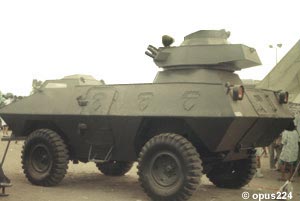
Hari-Digma
prototype APC. Thanks to opus for the pics, and to Manokski for the info..
Back to
top
Steelcraft
MX-1 Kalakian APC
Type: Armored Personnel Carrier (W)
Armor: 12mm (hull)
Crew: Commander, Gunner, Driver + 12 Troops
Air transportability:
Dimensions
Length:
Width:
Height:
Ground clearance:
Weights and loadings
Weight (Full): 10,582 kg (23,329.31 lb)
Power train
Engine: One x 250 hp (186.42 kW) Cummins 6-cylinder
in-line diesel, 300 liter (66 US Gal) fuel capacity
Power-to-weight ratio:
Transmission: Allison 4x4 transmission
Transfer case:
Axles:
Tracks:
Suspension:
Performance
Max land speed: 100 kph
Water speed:
Acceleration:
Range:
Vertical obstacle:
Trench:
Gradient:
Side slope:
Turning diameter:
Weapon Systems
Main gun: 12.7 mm HMG in turret
Max effective range:
Rate of fire:
Ammunition:
Ammunition type:
Rangefinder:
Night gun sight:
Secondary gun: 1x 7.62 mm coax mount and 1 x 7.62
mm rear gun
Max effective range:
Rate of fire:
Ammunition:
Ammunition type:
Rangefinder:
Night gun sight:
Other defenses: 1 x 40 mm AGL
Program: The Kalakian (Water Buffalo) is a
locally built wheeled APC which was designed as a larger,
improved, local version of GKN's Simba APC. Developed in
the early 2000s as a joint project between PA's Light
Armored Brigade (later Light Armored Division) and
Steelcraft Industries, Incorporated of Manila,
Philippines, the prototype vehicle, presented to the
Light Armored Brigade in December 2002 featured a one-man
turret and rear gunner's position. The vehicle used a
commercially available transmission and other commercial
vehicle components, all intended to reduce unit cost. The
vehicle had an armored hull with the same thickness as
the Simba (12mm) equipped with two side doors and one
rear door. It can accommodate up to twelve fully equipped
troops.
It can mount a larger turret and a heavier weapons system,
the design was conceived to reflect the experience of
using the Simba in actual combat operations, including
having two side doors instead of the Simba's single one.
The turret was a modification of the Cadillac Gage 1-meter
turret found on V-150 armored cars also in service in the
Philippines. This turret was also produced in a modified
form in the Philippines by the Floro International
Corporation. The major difference was the incorporation
of an additional element allowing for the turret to be
armed with a .50 caliber machine gun, 40mm automatic
grenade launcher, and 7.62mm machine gun. The Cadillac
Gage turret could only be armed with 2 of those weapons
at any time. On V-150 and Simba vehicles the 40mm grenade
launcher was often added to the top of the turret. This
required the gunner expose themselves. The modified
turret allowed all the weapons to be fired from within
the turret.
Apparently the PA ordered 20 units, the status currently
which is unknown, most are showpieces in static Army
displays. The prototype vehicle was said to have cost the
Philippine government Php 8 M.
  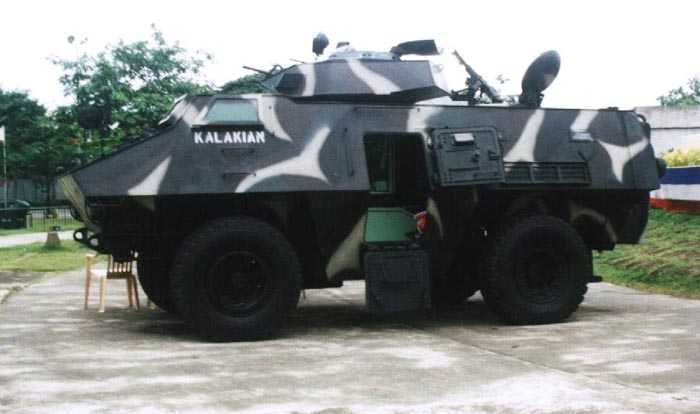
Army MX-1
Kalakian prototype APC. Thanks to opus and Frank for the pics and to Manokski for the info.
Back to
top
Steelcraft
MX-8 Mk.1/Mk.2/Mk.3 Armored Escort Vehicle
Type: Armored Vehicle (W)
Armor: Resistant to 7.62mm and .50 caliber ball
Crew: Commander, Gunner, Driver
Air transportability:
Dimensions
Length:
Width:
Height:
Ground clearance:
Weights and loadings
Weight (Full): 5,000 kg (11,023 lb)
Power train
Engine: Mitsubishi 130 hp (97 kW) Diesel
Power-to-weight ratio: 30:1 minimum (full combat
weight)
Transmission: Allison transmission
Transfer case:
Axles:
Tracks:
Suspension:
Performance
Max land speed: 100-120 kph (62-75 mph)
Water speed:
Acceleration:
Range:
Vertical obstacle:
Trench:
Gradient:
Side slope:
Turning diameter:
Weapon Systems
Main gun: 7.62 mm LMG in turret
Max effective range:
Rate of fire:
Ammunition:
Ammunition type:
Rangefinder:
Night gun sight:
Secondary gun:
Max effective range:
Rate of fire:
Ammunition:
Ammunition type:
Rangefinder:
Night gun sight:
Other defenses:
Program: The MX-8 Armored Escort Vehicle (unofficial
name, Barako or Wild Boar) was developed by Steelcraft
Industries, Incorporated of Manila, Philippines in the
mid-2000s as a low cost armored escort vehicle for the PA.
The MX-8 was said to be a 100% Filippino design utilizing
commercially available components. A 4x4 armored car with
mobility almost equivalent to HUMVEE with shorter turning
radius, a 1-man turret armed with a 7.62 mm machine gun,
it was intended to escort motorized infantry convoys
through hostile areas. This would free up heavier combat
vehicles for other operations and reduce the dependence
on improvised armored trucks then being used. The vehicle
was said to cost around Php 6 M, less than a third of the
cost of the GKN Simba, one of the PA's primary combat
vehicles.
Steelcraft Industries had also reportedly suggested that
the MX-8's roles and armament options could be expanded
depending on what needs the AFP identified. The initial
prototype (later referred to as the Mk 1) had been tested
with a .50 caliber machine gun or 7.62 mm M134 "Minigun"
in the turret, as well as unidentified "rocket
launchers."
In 2008 a Mk 2 prototype was announced with a revised
internal arrangement, a independent front suspension, and
various other minor modifications. Run-flat tires were
also installed as standard. The turret was modified to
have vision blocks all around, providing 360 degrees of
vision for the gunner. Perhaps the biggest change was the
increased ground clearance and installation of a V-shaped
hull design. The Mk 2 was developed as a private venture
and the modifications were not requested by the AFP.
A further improved Mk 3 appeared in 2009. It featured
another minor redesign of the hull shape. By that time
the 4 (2 Mk 1, 1 Mk 2, and 1 Mk 3) prototype vehicles
were already in service with the Philippine Army and
Philippine National Police.
Back to
top
Marine
Multi-Purpose Vehicle 4x4 (MMPV)
Type: 4x4 Multi-Purpose Vehicle
Armor:
Crew: 1 + 3
Air transportability:
Dimensions
Length:
Width:
Height:
Ground clearance:
Weights and loadings
Weight:
Power train
Engine: Mitsubishi diesel engine
Power-to-weight ratio:
Transmission:
Transfer case:
Axles:
Tracks:
Suspension:
Performance
Max land speed:
Water speed:
Acceleration:
Range:
Vertical obstacle:
Trench:
Gradient:
Side slope:
Turning diameter:
Weapon Systems
Main gun: M-40-A1 106 mm recoilless rifle or 12.7
mm HMG
Max effective Range:
Rate of fire:
Ammunition:
Ammunition type:
Rangefinder: 0.50 caliber spotting gun
Night gun sight:
Program: The PMC has produced a local version of
the HMMWV and called it the Marine Multi-purpose Vehicle
(MMPV). Sources say that it is a heavily modified
Mitsubishi Pajero (Montero in US), powered by the
Mitsubishi 2.8 L SOHC turbodiesel rated at 92 kW (123 hp/125
PS), transmission, chassis, and 4WD, with an electronic
transfer shift that could split power between both axles
without the need to stop the vehicle. It cost much less
than US-made Humvees, about P310,000 bare, with an
additional P35,000 for military equipment and
modifications. The Marines have been testing the
prototype with a M-40-A1 106 mm recoilless rifle that was
taken from Marine soon-to-be decomissioned M-151 jeeps.
While the Philippine Navy is negotiating for US-made
Humvees including several variants, the Marines will make
do with these local version. The prototype is currently
undergoing rigorous test to prove its reliability.
  
Two
images of the MMPV, taken at the Crow Valley in 2006.
Thanks to opus for the pics and Manoksi for the info.
Back to
top
Columbia
Motor Corp. Cruiser Jeeps
Type: 4x4 Utility Vehicle
Armor: None
Crew: 1 + 3
Air transportability:
Dimensions
Length:
Width:
Height:
Ground clearance:
Weights and loadings
Weight: 250 kg (550 lb)
Power train
Engine:
Power-to-weight ratio:
Transmission:
Transfer case:
Axles:
Tracks:
Suspension:
Performance
Max land speed:
Water speed:
Acceleration:
Range:
Vertical obstacle:
Trench:
Gradient:
Side slope:
Turning diameter:
Weapon Systems
Main gun: M-60 LMG
Max effective Range: 1,100 m
Rate of fire: 100 rpm
Ammunition:
Rangefinder: Optical
Night gun sight: None
Program: Built during the Marcos Administration
by the Philippine Army Research and Development Center (PARDC)
to augment the existing M-151 "Mutt" and "Kennedy"
jeeps. Still in service up to now. Some units are armed
usually with machine-gun(s).
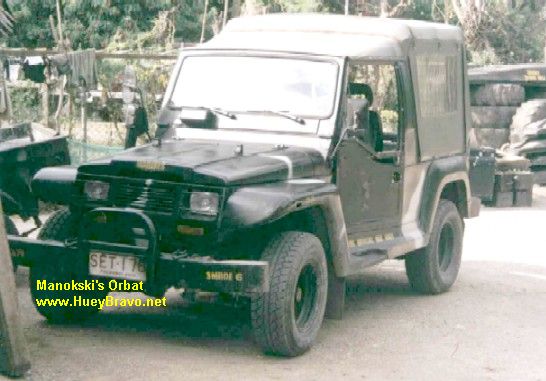  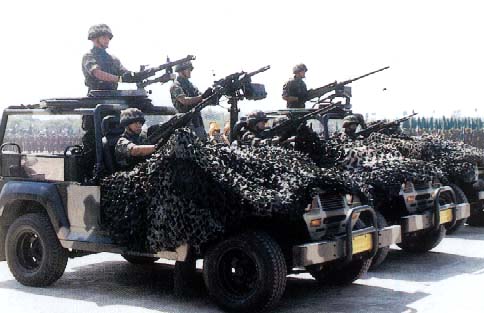
Photos of
AFP's CMC Cruiser jeeps, utility model on the left and
the armed model on the right. Thanks to Manokski for the pic.
Back to
top
Delta
Motors Mini-cruiser Jeeps
Type: 4x4 Utility Vehicle
Armor: None
Crew: 1 + 3
Air transportability:
Dimensions
Length:
Width:
Height:
Ground clearance:
Weights and loadings
Weight: 250 kg (550 lb)
Power train
Engine:
Power-to-weight ratio:
Transmission:
Transfer case:
Axles:
Tracks:
Suspension:
Performance
Max land speed:
Water speed:
Acceleration:
Range:
Vertical obstacle:
Trench:
Gradient:
Side slope:
Turning diameter:
Weapon Systems
Main gun: M-60 LMG
Max Effctive Range: 1,100 m
Rate of fire: 100 rpm
Ammunition:
Rangefinder: Optical
Night gun sight: None
Program: Military mobility project involving RDC,
Delta Motors Corp., and in a joint-venture agreement with
Toyota of Japan, produced the Mini-Cruiser, ¼-ton, all
terrain light vehicle most suited for AFP ground forces
which provided a worthy substitute for the M-151.
Back to
top
Missile
Systems
PAF
SDRDG /Dayton Metals Corp. Mk. 40 Mobile Assault Combat
Operational System 'Sumpak (MARCOS)' MRLS
Type: Mobile Multiple Rocket Launch System
Crew:
Caliber: 12 x 70 mm
Dimensions
Length:
Width:
Height:
Ground clearance:
Weights and loadings
Performance
Range:
Elevation: -5° to +55°
Traverse:
Firing Mode: Single or Ripple
Rangefinder: Optical
Night gun sight: None
Ammunition: 12 x 70 mm FFAR
Program: The Mk. 40 Sumpak was an experimental
trailer mounted modular MRL system initially developed by
the PAF SDRDG in 1981. Reconfigured as a 4x4 Mini-cruiser
mounted version by Dayton Metals Corp (a MARSTEEL Company)
in 1983, which greatly enhanced its mobility and
stability, it was intended for various applications such
as area attack, point defense and shore-to-ship
implacement, firing standard 70 mm HEAT, FFAR. Manual
elevation and traverse with plans to make it power-driven.
Tested in Fort Magsaysay, where four retractable anchors
were added to provide stability during firing to reduce
dispersed fire in full ripple mode. Project terminated in
1986 and the prototype sits at the PAF Aerospace Museum.
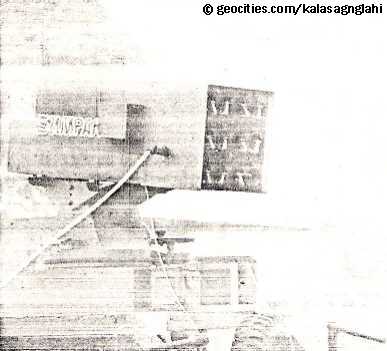
Mk. 40 "Sumpkak" scanned from
a PAF SDRDG Data sheet circa 1991.
Back to
top
SB
110 Rocket Launch System
Dimensions
Length, overall: 871 mm
Span: 277 mm
Warhead diameter: 110 mm
Rocket diameter: 110 mm
Height:
Weights and loadings
Landing weight: 15.1 kg (33 lb)
Weight, warhead: 6.8 kg (15 lb)
Weight, rocket motor: 8.1 kg (18 lb)
Weight, fuze: 0.2 kg (0.44 lb)
Program:
Designed and manufactured locally by the Philippine Army.
It is an experimental six-barelled launch system, which
can be mounted on trucks. SB 110 is the 110 mm version,
there have been reports of a 90 mm and 180 mm versions.
Back to
top
SANBA
aka "Bongbong" SSM
Type: Surface to Surface Missile
Dimensions
Length:
Diameter: 106 mm/ 180 mm
Height:
Ground clearance:
Weights and loadings
Performance
Range: 12 km (7.5 mi)
Speed:
Program: Initiated during the Marcos
administration as Project: Santa Barbara by the PN under
the Self-Reliant Development Program. Developed
clandestinely as a point defense weapons, by National
Science Development Board (NSDB), Universiity of the
Philippines and German engineers, headed by Commo.
Protacio in Sangley Point, Cavite, the project developed
several experimental variants and was powered by a solid
propellant, anhydrous hydrazine, the one used in the 7.2"
hedgehogs anti-submarine depth charges aboard the PN's DE's.
Prototypes were test fired in Fuga and Caraballo islands.
The project was shelved in '80s. Status is currently
unknown, most probably abandoned, with the stored
propellants reportedly converted to cleaning agents by UP
experts, which NAPOCOR bought and used for their boilers.
Back to
top
Aircrafts
XT-001
Basic Trainer
Type: Two, Three-seat trainer
Wings: Cantilever low-wing monoplane
Fuselage:
Tail unit:
Landing gear:
Accommodation:
Powerplant: One 260 hp (194 kW) Lycoming O-540-E4A5
flat-six engine, driving a two-blade constant-speed
propeller with spinner.
Systems:
Avionics and equipment:
Dimensions, External
Wing span: 8.40 m (27' 6 ¾")
Length, overall: 7.10 m (23' 3 ½")
Height, overall: 2.40 m (7' 10 ½")
Areas
Wings, gross: 10.10 m² (108.7 ft²)
Weights and loadings
Weight, empty, equipped: 720 kg (1,587 lb)
Typical mission weights
Max T-O weight: 1,200 kg (2,645 lb)
Performance
Never exceed speed:
Max cruising speed: 260 kph (140 knots; 162 mph)
Stalling speed: 120 kph (65 knots; 75 mph)
Rate of climb:
Service ceiling:
T-O run:
Landing run:
Combat radius:
Range:
Weapon systems:
Program: Designed and built by the PAF Self-Reliance
Development Wing in 1975 from locally designed jigs and
fixtures. It closely resembles the SIAI Marchetti SF.260MP
trainer, but with modified wingtips and cockpit and the
prototype was initially thought to be a modified SF.260MP.
Comparison of data with those for the SF.260MP indicates
a slight increase in wing span (though not in gross area),
a lower empty weight, and (despite a similar powerplant
and identical max T-O weight) a slightly reduced
performance. First test flight was also in 1975. Status
is currently unknown.
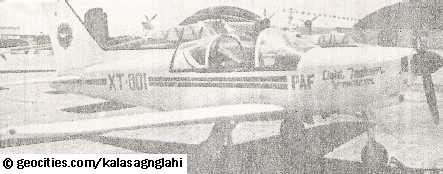
PAF XT-001 scanned from a photocopy of
Jane's All the World's Aircraft 1978-1979 edition.
Back to
top
XT-004
'Layang'
Type: Basic Trainer
Wings: Cantilever low-wing monoplane
Fuselage: Semi-monocoque aluminum structure
Tail unit:
Landing gear:
Accommodation:
Powerplant: 350 shp Allison engine
Systems:
Avionics and equipment:
Dimensions, External
Wing span:
Length, overall:
Height, overall:
Areas
Wings, gross:
Weights and loadings
Weight, empty:
Typical mission weights
Max T-O weight:
Performance
Never exceed speed:
Max cruising speed:
Stalling speed:
Rate of climb:
Service ceiling:
T-O run:
Landing run:
Combat radius:
Range:
Weapon systems:
Program: After an intensified and revitalized
Self-reliance program in 1996 the XT-004 Project code-named
"Layang" was developed by the PAF Research and
Development Center in Villamor Airbase, Pasay City. It is
a single-engine aircraft powered by a 350 shp Allison
turbo-prop engine and is constructed from aluminum with a
semi monocoque structure. According the PAFRDC, the
aircraft jigs and fixtures have already been built since
1985, but lack of funds hindered the completion of the
project. Status is currently unknown, probably shelved
pending further funding.
Back to
top
American
Jet Industries T-610 Super Pinto/Cali
Type: Two-seat Jet Trainer
Wings:
Fuselage:
Tail unit:
Landing gear:
Accommodation:
Powerplant: 12.7 kN (2,850 lb static) General
Electric CJ610-4 non-afterburning turbojet engine
Systems:
Avionics and equipment:
Dimensions, External
Wing span:
Length, overall: 9.58 m (31' 5")
Height, overall: 3.48 m (11' 5")
Areas
Wings, gross: 13.93 m² (150 ft²)
Weights and loadings
Weight, empty: 1,466 kg (3,225.20 lb)
Typical mission weights
Max T-O weight:
Performance
Never exceed speed:
Max cruising speed: 375 knots
Stalling speed: 63 knots
Max rate of climb at S/L: 2,743 m/min (8,997 ft/min)
Service ceiling: 14.63 km
T-O run at S/L: 152.43 m (500')
Landing run at S/L: 243.90 m (800')
Combat radius:
Range:
Endurance: 5.5 hours
Weapon systems: Provision for 6 underwing
hardpoints.
Program: A modified version of the Temco TT-1
Pinto jet trainer, originally powered by a Turbomeca
Marbore J69 turbojet and first flew in March 1956.
American Jet Industries (AJI), modified the aircraft for
Light Strike by changing the powerplant with the General
Electric CJ610-4 turbojet engine and extending the
fuselage by 2 meters. Wingtip fuel tanks were added as
well as provision for six underwing hardpoints and was
renamed Super Pinto. The prototype first flew in June
1968. The PAF bought the rights for the work drawings,
design and production of the aircraft from AJI in 1978
and had plans for the commercial production of the
aircraft and had it renamed Cali. After the Marcos
administration collapsed the project was shelved. Status
is currently unknown.

T-610
Cali scanned from a photocopy of Jane's All the World's
Aircraft 1978-1979 edition.
Back to
top
Limbas
Type: Jet Trainer
Wings:
Fuselage:
Tail unit:
Landing gear:
Accommodation:
Powerplant:
Systems:
Avionics and equipment:
Dimensions, External
Wing span:
Length, overall:
Height, overall:
Areas
Wings, gross:
Weights and loadings
Weight, empty:
Typical mission weights
Max T-O weight:
Performance
Never exceed speed:
Max cruising speed:
Stalling speed:
Rate of climb:
Service ceiling:
T-O run:
Landing run:
Combat radius:
Range:
Weapon systems:
Program: Acquired by the PAF in 1976 from the US
(probably the AJI Cali), the PAFRDC's revised project
designed the aircraft from scratch using a pure jet
powerplant, other changes made was the replacement for
the single canopy into a two-piece canopy, changes in
engine mount, intake and cover. The designs are kept by
the PAFRDC in microfilm, pending funding for further
research. Status is currently unknown.
Back to
top
Kalabaw
Type: Utility Aircraft
Wings:
Fuselage:
Tail unit:
Landing gear:
Accommodation:
Powerplant:
Systems:
Avionics and equipment:
Dimensions, External
Wing span:
Length, overall:
Height, overall:
Areas
Wings, gross:
Weights and loadings
Weight, empty:
Typical mission weights
Max T-O weight:
Performance
Never exceed speed:
Max cruising speed:
Stalling speed:
Rate of climb:
Service ceiling:
T-O run:
Landing run:
Combat radius:
Range:
Weapon systems: None
Program: One of the PAF RDC's projects which
intended to build a workhorse utility aircraft. The
aircraft has design similarities with the N-22 Nomad
transport aircraft, was in its preliminary design stages
when it was shut down. Status is currently unknown, most
probably abandoned.
Back to
top
Philippine
Army/Obi Mapua and Partners Model 5 Type 1 UAV/RPV 'Assunta'
Type: Tactical Unmanned Aerial Vehicle
Similar aircraft:
Wings: Cantilever high-wing monoplane.
Fuselage: Conventional wood semi-monocoque
structure.
Tail unit: Twin-boom type.
Landing gear: Non-retractable tricycle
type.
Ground crew: Pilot + 2 Sensor Operators.
Powerplant: One 40 cc two stroke engine
Systems:
Avionics and equipment: Autopilot system
with two GPS based preset waypoints. Onboard high
resolution camera effective viewing range 610 meters (2,000
feet) mounted in fuselage belly.
Dimensions, External
Wing span: 3.048 m (10')
Wing chord at root:
Wing aspect ratio:
Length, overall: 1.27 m (4' 2")
Fuselage max width:
Height, overall:
Elevator span:
Tailplane span:
Wheel track:
Wheel base:
Propeller diameter:
Areas
Wings, gross:
Ailerons, total:
Trailing edge flaps, total:
Fin:
Rudder:
Tailplane:
Elevator, incl tab:
Weights and loadings
Weight, empty, equipped:
Fuel:
Typical mission weights
Max T-O weight and landing: 13.61 kg (30
lb)
Max wing loading:
Max power loading:
Performance (at max T-O weight)
Max speed: 148 kph (50 knts; 99 mph)
Max cruising speed:
Stalling speed:
Max rate of climb at S/L:
Time to climb:
Service ceiling:
T-O run: 50 m (164')
Landing run:
Operational radius:
Range: 20 km (12.42 mi)
Endurance: 2 hours
AFP weapon systems: None
Program: Conceptualized in 1996-97 by
architect Obi Mapua, with several other prototypes Rica (proof
of concept), Ruffa, Alessandra and Claudia. Assunta
assembled in 2002 by the PA RDC and Obi Mapua and
Partners, using local materials (wood, aluminum,
fiberglass and styrofoam) to be utilized for short range
aerial reconnaisance in remote and mountainous areas in
various parts of the country. Tha basic UAV costs about
Php 250k and about Php 1m with complete avionics and
ground station. First successful joint PA-Mapua prototype
named Assunta launched in February 2002 at Fort Magsaysay,
the spy drone provides real-time comprehensive detailed
images (IMINT) of terrain conditions and enemy positions.
It can support the following missions: area
surveillance, route reconnaissance, environmental
protection, disaster assessment, and communications
enhancement. Three more units were reportedly undergoing
completion in 2002 until they were shut down by the Army
after 5 years of development after reportedly favoring
the Israeli Blue Horizon UAV.
Back to
top
Air
Munitions
AFM-M3
Cluster Bomb Unit (CBU)
Type: Air Munition
Bomblet: Standard 81 mm Mortar shell
Fuze: M-651 point detonating fuze
Dimensions:
Weight, overall: 39.05 kg (86 lb)
Performance
Max effective range:
Lethal zone:
Program: Developed by the PAFRDC at
Villamor Airbase in Pasay city, together with FIC and
PEFTOK Investment Development Corp. The AFM-M3 CBU
consist of six standard 81 mm morta shells and is
equipped with locally manufactured M-651 aerial fuzes. It
is held together by an all-metal clustering device
consisting of a carbonized 1015 carbon-steel gauge #20
shell strap and a standard 14 inch 1020 carbon-steel
suspension lug. It can be mounted on a standard MA-4A
bomb rack, which can be mounted on all aircraft and
helicopters. The CBU is intended effective for are
saturation bombing involving fleeing targets for COIN
operations. Currently still in use.
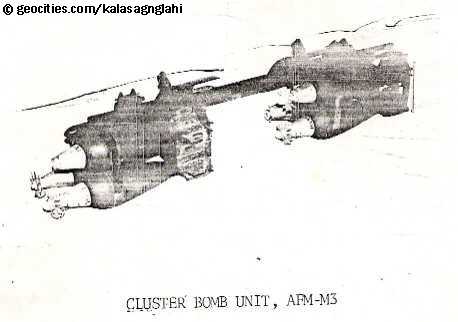
AFM-M3
CBU scanned from a PAF SDRDG Data sheet circa 1991.
Back to
top
External
Mounting Assembly (EMA)
Type: Air Munition
Dimensions
Length:
Width:
Height:
Ground clearance:
Weights and loadings
Weight:
Program: Developed by the PAFRDC at Villamor
Airbase in Pasay city, together with Elitool Incorporated
(Philippines). The External Mounting Assembly is
specifically designed for the Bell 205/UH-1H, to give it
a forward-fring capability consisting of various weapon
systems. The UH-1H equipped with EMAs now have access to
four hardpoints with standard MA-4A bomb racks, which can
be fitted with a maximum load of 500 kg (150 kg inboard
and 110 kg outboard). It is controlled by a front panel
installed fire control system, which has a provision for
emergency jettison of mounted air munitions. The
following combination can be used with the EMA (inboard/outboard):
12.7 mm HMG with 250 rds/ 7 x 70 mm rocket launcher; or
150 kg GPLDB/ 18 x 80 mm rocket launcher; or 6 x 81 mm
rocket launcher/ 8 x 68 mm rocket launcher; or 7.60 mm
LMG, with 500 rds/ 8 x 68 mm rocket launcher; or 12.7 mm
HMG, with 250 rds/ AF-337K; or 12.7 mm HMG, with 250 rds/
AFM-M3 81 mm CBU.
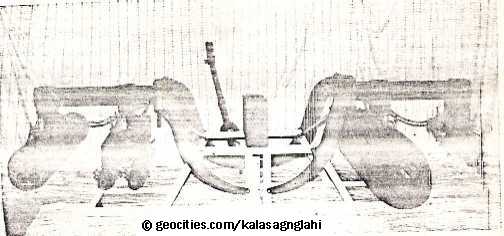
EMA
scanned from a PAF SDRDG Data sheet circa 1991.
Back to
top
Gulok
Type: Air Munition
Dimensions
Length:
Width:
Height:
Ground clearance:
Weights and loadings
Weight:
Program: Developed by the PAFRDC at Villamor
Airbase in Pasay city, in cooperation with various local
industries. The Gulok is a modular rocket launcher and
heavy machine-gun combined and can be mounted in any
aircraft with a standard 14 inch MA-4A bomb rack. It is
electrically operated by a fire control system. The Gulok
carries a 12.7 mm HMG and 4 x 70 mm folding fin aerial
rockets (FFAR).
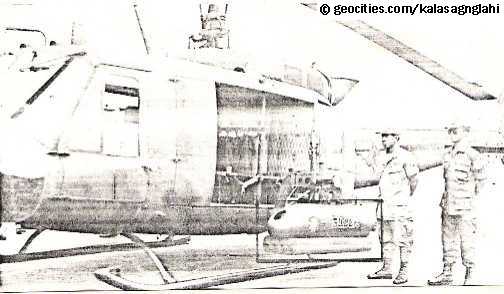
Gulok
attached to a MA-4A bomb rack, scanned from a PAF SDRDG
Data sheet circa 1991.
Back to
top
Watercraft
Pugo-class
Hovercraft
Type: Hovercraft
Displacement, full load:
Dimensions: m x m x m (' x ' x ')
Main Machinery: 2 x 225 hp reciprocating
aircraft engines
Speed:
Range:
Complement: 6-8
Weapon Systems
Main gun: 2 x 12.7 mm HMGs
Range:
Rate of fire:
Elevation:
Gunfire Control System:
Rangefinder:
Radars
Surface Search:
Range:
Navigation:
Sonar:
Builders: PAF SRDG
Program: During the PAF's Self-reliance
and Development Group (SRDG) 4th anniversary in 21
January 1977, a locally developed hovercraft dubbed 'Pugo'
was sucessfully launched in Manila bay. Work on the
hovercraft started on August 1975, with a succesful trial
run on 10 October 1976 in Jale beach, Paranaque. The
vehicle is powered by two 225 hp reciprocating aircraft
engines, one for the lift system that drives a 5 ft.
diameter centrifugal lift fan. It has a capacity of up to
2,000 lb. of cargo and up to 6 to 8 passengers. The
vehicle is mainly intended for the SAR role but can be
armed with two .50 cal MGs. Status currently unknown,
most probably abandoned.
Temper-class
LCM
Type: Landing Craft
Displacement, full load: 330 T
Dimensions: 23.46 m x 5.18 m x 2.74 m (77'
x 17' x 9')
Main Machinery: 2 x Fuso 140 hp diesels
or 3 x Isuzu 240 hp diesels
Speed: [Fuso diesel] 20 knts; [Isuzu] 30
knts
Range:
Complement:
Weapon Systems
Main gun: 1 x 12.7 mm HMG
Range: 1.80 km
Rate of fire: 450 rpm
Elevation:
Gunfire Control System: Manual
Rangefinder: Optical
Secondary gun: 1 x 7.62 mm LMG
Range: 1.10 km
Rate of fire: 100 rpm
Elevation:
Gunfire Control System: Manual
Rangefinder: Optical
Radars
Surface Search: Decca radar
Range:
Navigation: Decca radar
Sonar:
Builders: SRDP
Program: Developed in the late 80's
through the Self-Reliance Development Program. Prototypes
were tested with different engines. Status currently
unknown, most probably abandoned.
Back to
top
Weapons
System
Trident Strike HMG
Type: Automated HMG
Barrel length:
Bore diameter: 12.7 mm
Weight:
Range:
Rate of fire:
Elevation:
Muzzle velocity:
Ammunition:
Gunfire Control System:
Rangefinder: Electro-optical
Night gun sight:
Program: Developed jointly by the Navy Reserve
Force Division and the Mapua Institute of Technology
engineering students as an automated gunboat mounted
machine-gun in 2006. The gun is fired remotely below deck
by gunners. Prototype still currently undergoing testing.
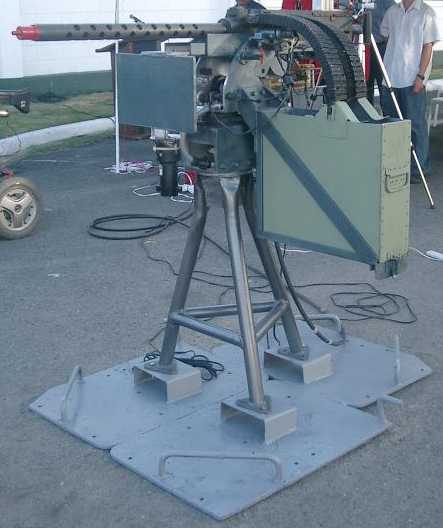
The
prototype 'Trident' automated weapon system, unveiled
during the Navy's 2006 anniversary.
Back to
top
Small
Arms
Marine
Scout Sniper Rifle/ Designated Marksman Rifle
Type: Sniper Rifle
Firearm action: Gas-operated, semi-automatic
Length: 107.32 cm (42.25"); [PN SWG model]
97.16 cm (38.25"); [NFWS] 80 cm (31.5")
Length of barrel: 60.96 cm (24"); [PN SWG
model] 50.8 cm (20")
Weight: 4.55 kg (10 lb); [PN SWG model] 3.64 kg
(8 lb)
Bore diameter: 5.56 mm (0.223")
Max range: 700 m (765.33 yd)
Max effective range: 600 m (656 yd)
Muzzle velocity:
Rate of fire:
Feed system: Detachable box magazine, 20 or 30
round capacity
Ammunition type: 5.56 x 45 mm NATO, 68 gr
Hornady or BTHP Match or 73 gr TAP BTHP Match
Rangefinder: Bushnell 3-9 x 40 mm with Mil-dot
reticle, mounted on DPMS Tri-mount on upper receiver.
Rear part of carry handle is retained to reinforce the
DPMS Tri-mount. Front sight post removed
Night gun sight:
Unit cost: [bare MSSR] P120,000; [bare NFWS] P40,000
Program: Developed in-house by N-6 out of need
for a dedicated sniper rifle for the PMC MBLT-6 in 1996,
the current model is a third generation sniper rifle
derived from the M-16A1 5.56 mm rifle. The entire weapon
system consists of the rifle, hard case, Otis cleaning
kit, binocular and a variable 15-35 x spotting scope,
with the itself rifle painted Marine paint schemes. The
rifle uses PMC-manufactured match-grade 5.56 mm and 7.62
mm ammunition from Hornady reloaders acquired in 2005,
which can produce 1,000 rounds a day. These rifles are
used by the graduates of the PMC's gruelling Marine Scout
Sniper Training School. The Navy Night Fighting Weapons
System (NFWS) is also a derivative of the M-16A1 and
produced in-house by the Navy research and development
group, with an integral suppressor/silencer and uses a
Litton Model M845 Mk.II Night Vision Sight or the Night
Optics D-740/760 Advanced Night Vision Weapon Sight as
night gunsights. The NFWS is slightly heavier than the
MSSR.

A
Marine Scout Sniper rifle on static display.
Back to
top
Government
Arsenal Special Assault Weapon-9 (SAW-9)
Type: Sub-machine-gun
Firearm action: Blowback, closed-bolt
Length: [overall] 65.5 cm (25.79"); [folded]
57.5 cm (22.64")
Length of barrel: 23.5 cm (9.25")
Weight: [with full magazine] 2.6 kg (5.72 lb)
Bore diameter: 9 mm x 19
Max range:
Max effective range:
Muzzle velocity: 400 m/sec (1,312 ft/sec)
Rate of fire: 850 rpm
Feed system: Magazine, 20 or 32 round capacity
Ammunition type:
Rangefinder:
Night gun sight:
Unit cost:
Program: The GA under the Self-reliant defense
program is conducting test on prototypes of a
9 mm Special Assault Weapon. The current weapons being
tested are fourth-generation prototypes and 10 units are
currently being field tested by the AFP in 2005.
Back to
top
Last
modified on 12/01/12

|














